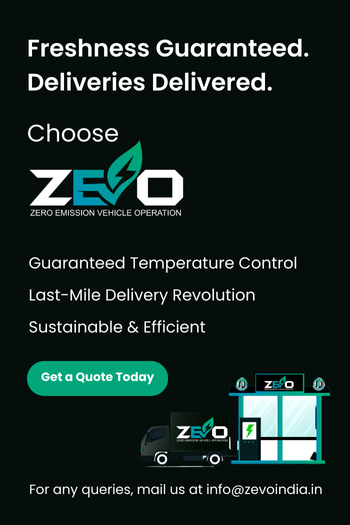The Pros and Cons of Refrigerated Last-Mile Delivery (Sustainable Approach)

Akshay Sharma
CEO's Office @ZEVO
In today’s e-commerce boom, ensuring fast and efficient delivery of products from warehouses to customers is crucial.
This final leg of the journey, known as last-mile delivery, plays a critical role in customer satisfaction and business success.
But for perishable goods like groceries, pharmaceuticals, and flowers, ensuring freshness and quality adds another layer of complexity. This is where temperature-controlled solutions come into play.
The demand for temperature-controlled solutions is skyrocketing. The global food cold chain last-mile delivery market is projected to grow at a rate of over 8% annually, reaching a value of $15.12 billion by 2030 [Source]
Refrigerated last-mile delivery – a rapidly growing solution that keeps temperature-sensitive items at optimal temperatures during transport. This approach guarantees fresh arrivals, but it also presents a challenge: balancing economic viability with environmental impact.
This blog post will delve into the advantages and disadvantages of refrigerated last-mile delivery. We’ll explore sustainable solutions and help you decide if this approach is the right fit for your business, ensuring both happy customers and a healthy planet.
Benefits of Refrigerated Last-Mile Delivery
Refrigerated last-mile delivery offers a multitude of advantages for businesses dealing with perishable goods. Here’s how it can benefit your bottom line, your customers, and the overall quality of your products:
Reduced Spoilage and Significant Cost Savings:
Traditional delivery methods can expose temperature-sensitive items to fluctuating temperatures, leading to spoilage and wasted inventory.
Refrigerated last-mile delivery ensures products stay within a controlled temperature range throughout transport.
According to a study by the Food and Agriculture Organization of the United Nations, roughly one-third of all food produced globally is lost due to spoilage.
By minimizing spoilage, refrigerated delivery can significantly reduce these losses for your business.
Extended Shelf Life: Fresher Products for Longer
Maintaining proper temperatures slows down the natural processes that lead to spoilage in perishable products.
This extends their shelf life, allowing them to stay fresh and maintain their quality for a longer period. For businesses, this translates to increased flexibility in inventory management and reduced risk of product expiration.
For consumers, it means receiving fresher goods that last longer, enhancing their overall satisfaction with your service.
Imagine the positive impact of delivering fruits and vegetables that retain their crispness and flavour for days after purchase, compared to wilted or overripe options!
Enhanced Customer Satisfaction and Brand Loyalty
Receiving fresh, high-quality products is paramount for customer satisfaction. Refrigerated last-mile delivery ensures that your customers receive their perishables in optimal condition, leading to a more positive experience.
Happy customers are more likely to become repeat buyers and recommend your business to others. Studies show that customer satisfaction significantly impacts brand loyalty, with satisfied customers more likely to repurchase and advocate for your brand
[Source: The American Customer Satisfaction Index].
By prioritizing freshness and quality through refrigerated delivery, you demonstrate a commitment to customer satisfaction, ultimately strengthening your brand reputation and fostering long-term customer loyalty.
Drawbacks of Refrigerated Last-Mile Delivery
While refrigerated last-mile delivery offers substantial benefits, it’s important to consider the potential drawbacks and find ways to mitigate them:
Cost Analysis: Finding the Right Balance
There’s no denying that refrigerated last-mile delivery comes with additional costs compared to traditional methods. Here’s a breakdown of the key factors:
- Upfront Costs: Refrigerated vehicles have a higher initial purchase price compared to standard delivery vans.
- Operational Costs: Maintenance for refrigerated vehicles can be more expensive due to the additional cooling equipment. Additionally, fuel consumption might be slightly higher due to the extra weight of the refrigeration unit.
- Infrastructure Investments: Depending on your operation, you might need to invest in additional refrigerated storage facilities to maintain optimal temperatures throughout the supply chain.
However, it’s important to consider the potential cost savings that can offset these initial investments:
- Reduced Spoilage: As mentioned earlier, refrigerated delivery can significantly reduce food waste, leading to substantial cost savings.
- Government Incentives: Many governments offer tax breaks or other incentives for businesses that adopt eco-friendly solutions like electric vehicles for refrigerated delivery.
By carefully evaluating these factors and exploring cost-saving options, you can strike a balance between implementing refrigerated delivery and maintaining financial viability.
Environmental Impact: The Responsibility of Sustainability
Traditional refrigerated vehicles contribute to emissions through fuel consumption. This raises environmental concerns that businesses need to address. Here’s how to ensure a more sustainable approach:
- Eco-Friendly Solutions: The rise of electric vehicles (EVs) presents a promising alternative. While EV technology for refrigerated transport is still developing, it offers the potential for significant reductions in emissions.
- Biofuels: Biofuels can be a viable option for traditional refrigerated vehicles, offering a cleaner burning alternative to conventional diesel or gasoline.
- Route Optimization: By optimizing delivery routes and minimizing travel distances, you can significantly reduce fuel consumption and emissions associated with refrigerated delivery.
By prioritizing these eco-friendly solutions, you can minimize the environmental impact of your last-mile delivery operations and demonstrate a commitment to sustainability, which is increasingly important for both consumers and businesses today.
Sustainable Solutions: The Rise of Electric Vehicles (EVs) for Refrigerated Delivery
Electric vehicles (EVs) are rapidly becoming the green giants of refrigerated last-mile delivery. Here’s why:
- Cleaner Air: Traditional refrigerated trucks are major polluters. EVs produce zero tailpipe emissions, leading to cleaner air in cities.
- Potentially Lower Costs: While upfront costs for EVs might be higher, electricity is generally cheaper than gasoline or diesel.
This translates to significant fuel savings. Additionally, EVs require less maintenance compared to gasoline-powered vehicles. - Addressing Limitations: Range anxiety and charging infrastructure concerns are valid. However, advancements in battery technology are happening rapidly.
- More Options: The market for electric refrigerated vehicles is booming. Major manufacturers like Daimler and Volvo are actively developing and releasing new EV models designed for cold chain logistics.
This provides businesses with a wider range of options to meet their specific needs and delivery distances.
Operational Efficiency for Sustainable Refrigerated Delivery
Refrigerated last-mile delivery requires a balance between efficiency and sustainability. Here are some key strategies to optimize your operations:
Smart Route Planning:
The first step to efficient and sustainable delivery is intelligent route planning. Utilize software that factors in traffic patterns, delivery locations, and weather conditions. This helps you:
- Minimize Travel Time: Reducing travel time cuts down on fuel consumption and emissions.
- Maximize Deliveries per Trip: Efficiently grouping deliveries reduces the total number of trips needed, minimizing environmental impact.
Maintaining Optimal Temperatures:
Temperature control is crucial throughout the delivery process. Here’s how to ensure optimal conditions:
- Pre-cooling: Pre-chill delivery vehicles and storage facilities before loading perishable goods.
- Minimizing Door Opening: Limit the number of times doors are opened during loading, unloading, and multi-stop deliveries. This prevents warm air from entering and compromising product quality.
- Proper Insulation: Invest in well-maintained, high-quality insulation for vehicles and storage units to minimize temperature fluctuations.
Real-Time Temperature Monitoring:
Technology plays a vital role in maintaining optimal temperatures. Consider implementing real-time temperature monitoring systems:
- Alerts and Tracking: These systems provide real-time data on temperature fluctuations within the delivery vehicle. This allows for immediate intervention to prevent spoilage.
- Improved Decision-Making: Data gathered can be used to identify areas for improvement, such as optimizing route planning or adjusting pre-cooling protocols.
By implementing these strategies, you can optimize your refrigerated last-mile delivery for both efficiency and sustainability. This translates to reduced environmental impact, minimized product spoilage, and ultimately, a more cost-effective and customer-satisfying operation.
The Future of Sustainable Refrigerated Last-Mile Delivery
The future looks bright for sustainable refrigerated delivery:
- Autonomous vehicles: Self-driving trucks with advanced temperature control could optimize efficiency and eliminate human error.
- Urban consolidation centers: These hubs would reduce transportation needs by storing products and fulfilling orders locally.
- Government regulations: Stricter emission standards and EV incentives can push for sustainable practices.
- Collaboration: Businesses, tech providers, and governments working together can accelerate innovation for a greener cold chain.
Making the Decision: Is Refrigerated Last-Mile Delivery Right for You?
Refrigerated last-mile delivery offers significant advantages for perishable goods, but it’s not a one-size-fits-all solution. Here’s a framework to help you decide if it’s the right fit for your business:
Know Your Products:
- Temperature Requirements: What are the specific temperature needs of your products? Some items require constant freezing, while others need precise temperature control within a specific range.
Consider Your Customers:
- Customer Base & Delivery Range: Where are your customers located? Long-distance deliveries for temperature-sensitive items necessitate refrigerated transport.
Volume and Budget:
- Delivery Volume: How many deliveries do you make daily? High-volume operations might benefit more from refrigerated last-mile solutions.
- Budget Constraints: While refrigerated delivery can lead to long-term savings (reduced spoilage), evaluate upfront costs and potential return on investment (ROI).
Sustainability Goals:
- Environmental Impact: Are sustainability practices a priority? Refrigerated vehicles have environmental considerations, but there are ways to mitigate them (discussed earlier).
Alternatives to Consider:
- For short distances or less temperature-sensitive items, insulated packaging can be a viable alternative.
The Bottom Line:
By analyzing these factors, you can make an informed decision. Refrigerated last-mile delivery can be an investment in customer satisfaction, product quality, and ultimately, the success of your business.

Share this Article
Subscribe to our newsletter
Be the first to receive exclusive offers and the latest news on our products and services directly in your inbox.
